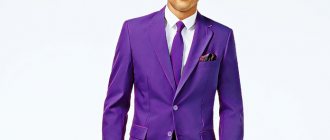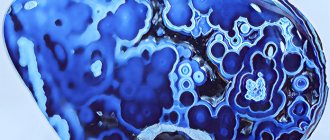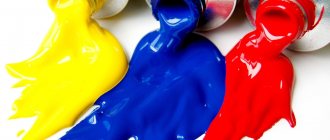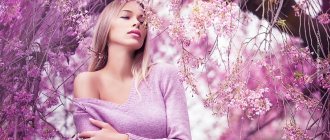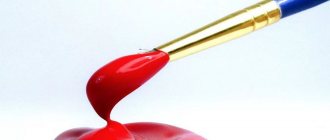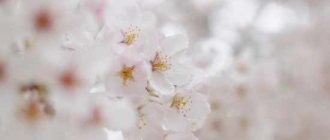Few people think that colors, just like circumstances, situations and people, can influence our mood, well-being and even behavior. Today we will talk about the effect that lilac and violet colors have on the human psyche.
In everyday life, not every person thinks about the fact that color can somehow influence his psyche and mood, however, in fact this is so. Each color has its own meaning and, accordingly, each color has a different effect on the psyche; in this article we will talk about purple and lilac.
What does purple, lilac color mean for women?
Violet color is very often classified as a so-called feminine color, since it is quite bright, eye-catching, passionate, but at the same time gentle, deep and mysterious.
Women who love purple and lilac colors have a number of characteristics. Here are the main ones:
- These people are individualists. For such women, freedom of speech, thought, and self-expression is above all. They never allow anyone to limit themselves in anything and always independently make all decisions that affect them.
- Extremely emotional individuals. Women who have a craving for such colors are more emotional than all others. They are quite easily thrown off balance; they do not know how to hide their feelings and emotions. If a purple lover wants to cry, she will cry; if she wants to laugh loudly, she is welcome; kissing a stranger is easy. Women do not see anything bad or harmful in their emotionality.
- Vulnerable and defenseless. Despite such a fiery character, these girls need support, support, a strong shoulder. They are highly sensitive and take everything to heart.
Women
- Lovers of purple live according to the rules and foundations that they consider correct and true. It must be said that next to such women there can only be those people who completely share their worldview and interests.
- If a woman has never paid attention to the color purple, lilac , and now suddenly falls in love with it, she should expect serious changes. Very often, such changes include the birth of a child, since purple is considered the color of pregnancy.
- Also, the color purple for a woman means her confidence in herself and her abilities. Internally, such women feel this power, but outwardly it may not manifest itself at all.
Shades of purple
Real purple color is dark, deep and rich. But in nature it practically does not occur; much more often you can see mixes that lead either to the warm red range or to the cold blue range. Moreover, despite the fact that white, black and gray cool colors can also be an admixture of purple, warm purple shades are still in the overwhelming majority.
Important! It is believed that light, soft pastel colors have a more beneficial effect on the human psyche than aggressive dark ones.
Dark purple. One of the darkest shades of the palette is the color of the abyss, losing its beginning and end and going into the depths of infinity. Purple denotes the secrets of the universe, black - animal, primal fear. Dark purple makes you tremble with anticipation of a miracle on a universal scale. Cold detachment, severity and restraint, this is what this color is associated with.
Black and purple. Despite the fact that black is associated with sin, devilry and death, black-violet is a fundamental color, a shade of stability and constancy. The color of deep night, associated with the otherworldly, devilish world. Together with purple, the shade takes on a mysterious character. At the same time, there is no anxiety in it, it is not depressing, as it might seem initially.
Purple blue. The fantastic color of twilight, in which the subconscious itself draws the vague outlines of images. Purple in this shade is the color of the unconscious, and blue is the color of the incomprehensible, and together they form fantasy, space, isolation from reality, a fairy tale with its magical characters: mermaids, gnomes, elves and werewolves.
Purple-red. If purple means detachment from the worldly and calmness, then red, on the contrary, involves and forces you to take active actions. Purple-red is the color of sexual desires. And if purple itself has a stimulating effect, then in combination with violet it awakens deep subconscious, sophisticated desires, which in a certain sense can even be dangerous.
Purple. Combining the two opposites of red and blue, purple becomes a shade of balance, but at the same time duality, awareness and restraint, but at the same time lust. Purple represents the feminine and masculine. Shows the path from base instincts to enlightenment and achievement of the final stage of personality formation, as a person created in the likeness of God.
Grey-violet. Purple, filled with the mysteries of the universe and the sounds of space, in combination with a modest and calm gray color, becomes more down-to-earth, ordinary, although no less detached and lonely. The gray-violet hue is ideal for people who seek privacy and want to hide in their shell, while also being gifted creative individuals. In nature, gray-violet can be found in stormy skies, on stones that have been lying on the ground for thousands of years, in the form of poisonous mushrooms. This shade seems to take us into eternity, but earthly, making us think about the versatility and breadth of the universe.
Lilac. This is the color of femininity, calmness, peace, it relieves irritation and puts you in a romantic mood. Along with the lavender shade, lilac is enchanting. This is the color of magical adventures, filled with fairy tales, love experiences and spring with its crazy floral scents.
What does purple, lilac color mean for men?
For men, purple and lilac mean something completely different. It is worth noting that such colors are not often liked by males, since they are too bright and delicate for them.
- A man who prefers the color purple is distinguished by wisdom and experience. His passion for this color indicates that he sees and feels the world around him completely differently than everyone else. He can understand what remains unknown and inexplicable to other people.
- Such men want to understand the secrets of this world, touch the secret desires of themselves and learn to fulfill them.
Perception
- Men who love purple are often taciturn, a little “in themselves”, detached from the whole world.
- Very often, men’s attraction to such colors indicates that they want and can help other people. Sometimes this manifests itself in super abilities, which are often endowed with men who love the color purple.
- There is a slightly different opinion about the meaning of purple and lilac for men. Some men prefer such colors to express themselves and attract the attention of others, especially women.
Gray (0)
Gray is neither color nor light nor dark. He is absolutely not annoying and has no mental tendencies. Gray color is the neutrality of both subject and object, both inside and outside, it is neither tense nor relaxed. Gray is not a territory that can be revived, but simply a border; the border as no-man's-land, the border as a contour, as a dividing line, as an abstract division to separate opposites from each other, "gray is only territory" as an abstraction.
The one who chooses the gray color, the border, in the first place, does not want to give himself away and wants to protect himself from all influences, so as not to get excited. In case of severe fatigue (as an expression of guarding) and in an exam situation, since they do not want to give themselves away, gray is often preferred to the others. The one who chooses the gray color in last place wants to attract everything within his borders, which may be perceived by others as interference. He considers gray a boring color and banishes its lifeless peace to the last place in the row. He prefers all other colors, full of affect, along with their contradictory tensions, because they express exciting experiences. One who rejects the color gray binds himself because of his own readiness for excitement and is afraid of being left out. He would like to exhaust all possibilities, striving to achieve the goal, and at the same time a state free from excitement. Anyone who puts gray in second place divides his world, on the one hand, into a zone that is compensatingly overvalued, which is represented by the color in first place, and on the other hand, into a zone represented by all the others that are next to gray, devalued or repressed colors, or, accordingly, life possibilities.
Even if gray is in third place, the discrepancy between the recognized colors up to borderline gray and subsequent colors is still so intense that first and second place should always be judged only as compensations. Colors that, during repeated test recordings, stand once before and once after gray, that is, they are either placed in front of the gray wall, then, in accordance with the instantaneous state of conflict, are hidden behind it again, such colors accompanying gray are charged with conflict, if only gray appears in the first half of the row.
According to statistics, gray color occupies, on average, sixth place. He can move up to fifth or seventh place without any doubt. In all other places he attracts attention. In case of fatigue and an examination situation, he moves to the front.
What does bright lilac, purple color in clothes mean: psychology
Many people, especially women, love such colors in clothes, however, they are not suitable for everyone. So, first, let's figure out which people prefer purple and lilac colors in clothes:
- Self-sufficient. The purple color is quite strict and restrained, of course, if you do not choose its flashy shades.
- Self-confident, without complexes. Despite the whole range of shades, purple and lilac colors are still bright and somewhat provocative. As a rule, when dressing in clothes of such colors it is very difficult to go unnoticed.
- Those who want to stand out from the rest.
- Mysterious, because purple and lilac are unusual, mysterious colors.
In clothes
A person’s desire to dress in purple clothes means the following:
- The desire to create a romantic and unusual image. Purple color is perfect for creating a romantic image and mood.
- Declare yourself to the whole world without being afraid to show your shortcomings. In most cases, the lilac color does not hide flaws in the figure and appearance, but rather emphasizes them. However, many people are not afraid to show their imperfect body and appearance, and even on the contrary, they strive to show that there is nothing wrong with it.
- Emphasize your importance in society and financial well-being. Since ancient times, these colors have been considered the colors of the elite, rich, wealthy and powerful people. Some people still have this idea of color today.
- Emphasize individuality and special position. Often pregnant women are drawn to this color in clothing, since it symbolizes a transition to a new state, the beginning of something new.
Original, slimming
It is worth noting that it is not for nothing that many people like the purple color in clothes, because it:
- Visually slimming.
- Indicates individuality, originality.
- Arouses interest among others.
- Emphasizes self-confidence and self-sufficiency.
Impact on mood and health
In most cases, the violet spectrum has a beneficial effect on humans. It calms, helps cope with tachycardia, evens out breathing, normalizes blood pressure, and eliminates panic attacks. There are other aspects:
- Opens up corners of memory hidden deep in the subconscious.
- Relaxes, relieves stress, promotes rapid sleep (in moderation).
- Helps get rid of anxiety, look at problems from the other side, and restore inner harmony.
- Accelerates the recovery of health after operations or serious injuries, including mental ones.
- With regular training, it improves vision.
- In mediation practices it is used to cleanse the mind of stereotypes and templates, and tunes in to sincere and selfless behavior.
- Activates creative thinking and encourages active activity.
Despite these benefits, sometimes a so-called color overdose occurs. In this case, a person faces a state of depression, emotional overstrain, and depression.
What does lilac, violet eye and hair color mean: psychology
Of course, in nature, violet, lilac eye colors and curls are not found in principle, however, in the modern world it is still possible to meet a person with such eyes and hair.
- Most often, young, impulsive people choose these colors to change their appearance. Older people, as a rule, prefer calmer colors, and do not wear colored lenses at all.
- Lilac and violet eye colors are a desire to stand out from the rest, to attract attention, to declare individuality. That is why teenagers most often dye their curls in these colors.
To stand out
- Why do teenagers choose purple for these purposes? Because it is unusual, bright, it is much less often chosen compared to, for example, red, red, which means it will attract much more attention.
Red lipstick attracts men's attention2
Lips painted in any color attract attention, albeit unconsciously. But which color can attract the most attention? Scientists from the University of Manchester have found that men look more at women's lips when they are wrapped in crimson, bold cherry or sultry red. Analyzing the eye movements of 50 men, the results showed that they looked for 7.3 seconds at red lips, 6.7 seconds for pink lips and 2.2 seconds for women who weren't wearing lipstick. So, run to the store and stock up on red lipsticks!
What does lilac, purple color mean in the interior: psychology
As for the purple and lilac colors in the interior, it attracts many, but almost everyone refuses it, fearing that the color will quickly get boring, will begin to “put pressure” on the head, etc. Indeed, purple is a difficult color, quite aggressive, if we talk about interior, and is not suitable for everyone, but you shouldn’t completely abandon it, because there are different options for its implementation.
- Most often, creative . For them, it is a beautiful, sensual and rich color that creates coziness and warmth in the house.
- Also, these colors are used by people with unconventional thinking and unique personalities.
- Purple color in the interior is not always a desire to stand out and surprise someone, sometimes it is just a love of color, understanding and acceptance of it.
Note that each room in the house has its own purpose and therefore the choice of color for its furniture, walls, etc. must be selected individually, taking into account all the features. As for purple and lilac colors, we can say the following:
- Kitchen, dining room. A person does not spend too much time in this room, so here you can give free rein to your imagination and use the purple color as you please. To decorate the dining room, you can give preference to bright, flashy shades.
Perfect
Beautiful
- Bedroom . To decorate a relaxation room, you should not choose flashy shades of purple and lilac, since they can cause aggression, excite the imagination, increase fears, etc. For this purpose, it is better to give preference to calm shades, for example, lilac, delicate purple with an advantage of pink, or make an accent on one piece of furniture. For example, you can decorate the bedroom in light colors, but give preference to a dark purple bed, or make only one of the walls of the room purple, and paint/paste the rest in warmer and calmer colors, adding some beautiful purple accessories.
In the bedroom
Gently
- Living room. This room should be done the way your soul desires, since you will be greeting guests in it, hosting gatherings, and generally spending a lot of time. Experts recommend not decorating the living room in one color; it is better to dilute the purple color with its other shades. A combination of beige and plum, lavender and milky is perfect.
Gorgeous Beautiful
- Children's room. Most often, these colors are used to decorate a room for little princesses, however, this color in a room may also be suitable for boys. For girls, choose more delicate tones and shades, for example, lilac, light lilac with beige or pink. Darker combinations are suitable for boys, for example, plum and coffee, white and purple, etc.
Children's
Stylish
To the boy
- Personal Area. To decorate your personal account, it is better to give preference to dark shades of purple. These include plum, black grape, eggplant, etc. Purple color goes especially well with wood.
In the office
- Toilet and bathroom. These rooms can be decorated in any colors, tones and in any combination. In this case, it is better to take into account the practicality of the color and its wear resistance. Dark shades will hide imperfections in the room and will be easier to maintain.
Stylish in the bathroom
Yellow color (4)
Yellow color is the lightest bright paint, and therefore affects easily and vividly. Red seems denser and heavier than yellow, which is why it excites. Since yellow appears lighter, much thinner and weightless than red, it is stimulating. In accordance with this, it increases autonomic functions: blood pressure, increases heart rate and breathing in the same way as the color red does, but is immeasurably more labile. The main feature of yellow is that it reflects light, and therefore radiates brightness in all directions, weightless cheerfulness. Yellow light corresponds to unhindered expansion, liberation. In contrast to bluish-green, which reflects contraction of tension to the point of convulsions, yellow represents release and relaxation. Psychologically, liberation means liberation from something heavy, something oppressive or paralyzing.
If yellow is chosen first, then it indicates a desire for liberation and hope for or expectation of happiness. The expectation of happiness in all its myriad forms, from sexual adventure to ideologies that promise an ideal state at the end, is always oriented towards the future. Whenever in a series of eight colors green and yellow stand next to each other and form one group, then tension and release are combined for the purpose of direct release of tension and neutralizing balancing of tension.
Anyone who prefers green and yellow needs immediate recognition; he wants respect. He watches with great tension to see whether he is given the expected appreciation and confirmation so that the tension (+ green) can be released (+ yellow).
Green is persistence, yellow is change. Green is voltage, yellow is discharge. Between these poles lie conflicts that grow out of dissatisfaction. Here, “green” ambition, self-affirmation and prestigious claims fight against the “yellow” desire for experiences, filled with the expectation of happiness. If the green color achieves an advantage, then the smooth muscles also become subject to constant coercion, so that this can manifest itself in the form of spasms of the gastrointestinal tract or cardiovascular system, that is, in the form of pathological disorders. Since the tension is unbearable, most often these patients reject the green color, while compensatory preference is given to yellow due to the desire to free themselves from the spasmodic state.
If yellow is in seventh or eighth place, this is a disappointment in hopes. A person stands in front of emptiness and feels isolated. Due to the seriousness of the mood in this case, the brightness and intangibility, the lightness of the yellow color is perceived as emptiness and a deceptive surface. Since, due to disappointment, the tension of expectation cannot come to any resolution, overstimulation sets in, so the yellow color is rejected as too bright. Overexcitation manifests itself in irritability, anger, bad mood and distrust. If you think that many people feed their interest in life with expectations and hopes, then you can understand the destructive effect of hopelessness, revealed by the rejected yellow color, i.e. a fearsome absence, at least for a significant part of life.
Yellow in seventh or eighth place means “preserving yourself from disappointment, loss and isolation.”
compensation is varied. Often the color blue is chosen first. This shows that there is a need for peace and affection as a means of satisfaction. The rejection of the color yellow and at the same time the preference given to the color blue reflect the painful attachment that can be found in many people. This type of love is often marked by features of masochism. Hopelessness can also be offset by a desire for confidence and affirmation. In this case, green comes first as a necessary means. If the color red comes first, then the most intense experiences possible, especially sexual intoxication, should help to forget disappointment and isolation. Yellow color attracts attention if it is not in places two to five.
Lilac, violet color: interesting facts
There are many interesting facts about these mysterious and bright purple and lilac flowers. Here are the most interesting of them:
- In ancient times, the color purple was a real rarity and an extraordinary luxury. The Greeks knew and practiced only one method that allowed them to obtain a dye of this color. This dye was extracted by processing huge quantities of a certain type of snail. This is what determined such a high cost of purple items.
- Few people don’t know the famous expression “I’m purple,” which means the same thing as “I don’t care,” but few people know why they say it that way. And the point here, oddly enough, is chemistry, or rather chemical reactions. If litmus (an indicator of acidity) is placed in an acidic environment, it will turn red ; if in an alkaline environment, it blue ; and if in a neutral environment, it will turn purple. This is actually where this expression comes from.
- 16 years ago, an unusual incident occurred at the Argentine Zoo, which made it twice as popular for a whole month. One of the zoo's residents, a polar bear, had an allergic reaction to a medicine for dermatitis, as a result of which the animal's fur turned purple and remained in this state for a whole month.
- In the Incan knot writing, the color purple meant the ruler of villages and territories.
Each person has his own attitude and idea about the color purple, some like it, some don’t. In general, as they say, there are no comrades according to taste and color. The main thing is to remember that our psyche, mood and state are influenced not only by circumstances, people, but also by colors.
Blue color (1)
The dark blue color represents peace free from irritation. When viewing dark blue, vegetative calm occurs. Pulse, blood pressure, respiratory rate and guard functions are reduced and trophotropically regulated. The body adjusts to a gentle regime and rest. With illness and languor, the need for blue increases. Sensitivity and willingness to perceive painful sensations increases. Dark blue is, like each of the four primary colors, a color expression of a biological need: physiologically it is peace, psychologically it is satisfaction. Satisfaction is a period when there is peace and contentment. Anyone who is in such a balanced, harmonious state, without tension, feels adjusted, belongs to the team and is safe. Therefore, the color blue represents attachment to everything around us: unity, close connection. And people say: “The color blue is fidelity.” In a state of unity, they feel especially sensitive to differences. Therefore, blue color corresponds to all types of emotionality (sensibility).
From the basic meaning of blue, countless special meanings and possibilities can be seen from different angles, of which only a few have been mentioned here. Blue color, as a calm (discharged) emotionality, is a prerequisite for feeling for aesthetic experience and spiritual thoughts. The color blue represents eternity and therefore also tradition. If dark blue is rejected in a test as unpleasant, then the need for peace and trusting affection remains unsatisfied. Existing human or professional attachments are rejected because they do not live up to the expected ideal and are considered boring or paralyzing. Since existing attachments are burdensome and depressing for the chooser, he strives to avoid them. Rejecting the color blue means running away from relaxation and peace, believing that you cannot afford peace at the moment without giving up something important. Premonition says that relaxation and peace can cause that very weakness and relaxation that is so feared, most often without realizing it. Relaxation can just lead to depression, which they want to avoid. For such people, the blue color is not a “charming nothing,” but a threatening nothing: since for them the basic need for affection, which the blue color represents, is not embodied in a significant way; often this is an attitude towards a partner (in love); sometimes it’s an attitude towards the work team or even towards the place where you have to live. Someone who always rejects the color blue is “deprived of the calming influence of belonging” that he so needs. The result is a restless and tense restlessness, constant self-inflation and search for excitement in order to avoid the lurking relaxation or even depression that results from such a lifestyle devoid of meaning.
In a study of 5,000 cigarette smokers, it was found that more than half of them rejected the color blue, especially those who smoked dark, strong varieties of tobacco. Here, probably, the stimulating effect of smoking is defensive, and is used to avoid relaxation. With excessive exposure to irritants (for example, television) and instability, restless behavior, the ability to concentrate also suffers, which is expressed, especially in children, in difficulties that arise when studying. Prolonged excitement can lead to neurotic organ diseases in adults. The repression of the dark blue color, as an unsatisfied emotional attachment, can, as compensation, contribute to the preference for the green color. Since green means self-affirmation, this gives rise to a claim to proud oppositional independence, which can often be found among young people who want to free themselves from family ties. But the aversion to dark blue - like fear of peace - is often compensated by red, which means "thirst for exciting experiences." If an unsatisfied spiritual attachment uses red in the first place as compensation as a “necessary means,” then “passionate” sexual intoxication arises because of this.
Often the rejected blue color requires yellow as compensation. The color yellow means “seeking a liberating outlet.” Depressing, unsatisfied emotional attachment here requires, first of all, relief to eliminate depression. Unsatisfied emotionality turns into a non-stop search for a way out. This is not only liberation from mental vulnerability, but also a search for satisfying harmony, which can find expression, among other possibilities, also in the search for the meaning of life (worldview) or in a mathematical mindset. On average, according to statistics, the color blue should be paid attention to if it does not occupy places from first to fourth.
Combination with other colors
Dark, rich purple goes well with lighter, calmer shades. The new tone, formed from a combination of purple with other colors, is endowed with a completely different, unique idea and meaning.
Purple with pink is a harmonious combination, since most shades of pink come from purple, for example, lilac, magenta, fuchsia, etc. The combination is feminine, deep and magical. Purple and red are a very bright pair, playing on the contrast of light-dark and warm-cold. Purple looks good with garnet, ruby, and burgundy. Purple and orange are no less rich contrast than the previous one. Plus, it adds the effect of an additional yellow color, which is part of orange. The tandem of purple with peach, honey, tangerine, and coral-orange looks unusual and bright. Purple with yellow is a very bright spot. In this case, purple will look better with calmer shades, for example, amber, saffron, brown-yellow. Purple with warm tones of green looks noble and vintage. Warm green shades include yellow, but here it is muted, calm and dark. You might consider a combination of purple and grassy green, light green or light green. Purple with cold tones of green is a gloomy tandem, a cool palette that enhances the passage of time. The role of green can be menthol, mint, jade or a shade of patina. Purple with blue and blue represents space, the abyss, and a riot of fantasy. Shades such as blue-green, dirty blue, soft blue, and water blue go well with purple. Purple and brown are a calm color scheme with a vintage twist. Brown, as a derivative of orange, plays on the contrast of warm-cold, muted. You can consider shades of milk chocolate, cinnamon, light chestnut. Purple with white, black, flesh and gray can either enhance or deepen the main purple tone if it is combined with gray wood or anthracite, for example, or make it lighter, less saturated. This is how the tandem of violet works with beige, light gray, and milky. Violet with its tones can create a multifaceted single shade. Tones and halftones, as close as possible to each other, transform and enliven the color, bringing newness to it. Combinations of violet with purple, violet, blackberry, and violet-blue are ideal in this regard.
One purple, being the embodiment of spiritual wealth and unity with the cosmic mind, is worthy of the title of king of all colors. People seeking the truth and meaning of life, craving harmony with the world, wanting to use their hidden potential need violet energy like no other. The main thing is not to overdo it with this color, so as not to lose touch with reality and not lose the ability to see the world in all its colors, and not just in purple.
How do color therapists decipher purple?
In the section on colors in psychotherapy, it is stated that this shade slows down and depresses the human psyche, causing irritation, a feeling of fatigue and dissatisfaction. However, some experts recommend lilac for relaxation and getting out of a rebellious state.
Purple is a widow's color that conveys grief, melancholy, and symbolizes inaction and sadness.
Widow's color - what?
In Russia, it has long been believed that a widow after the death of her husband should wear black clothes for six months. For the next six months, her outfits were supposed to be a purple widow's color, close to black, just as gloomy and depressing. It was also possible to use dark green or blue clothes in your wardrobe.
Wearing purple shades for a long time in people's eyes began to be associated with the status of a widow. So it became entrenched in the subconscious of society that such colors are worn only during mourning.
Lilac color is a widow’s color, why is it like this? The answer is simple, this shade is close to purple, so many also began to attribute it to this sad category. Similar superstitions have survived to this day. But increasingly, young people do not listen to depressing signs and, despite everything, couples prefer to organize even purple weddings.
